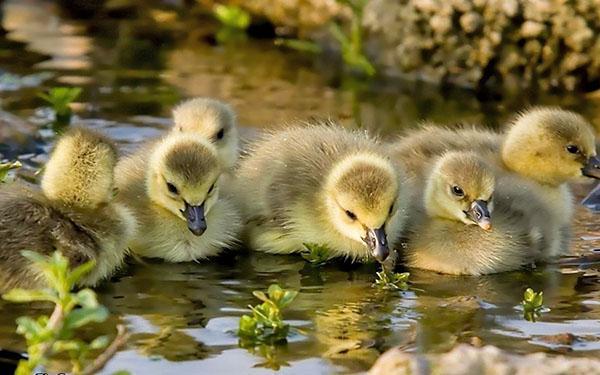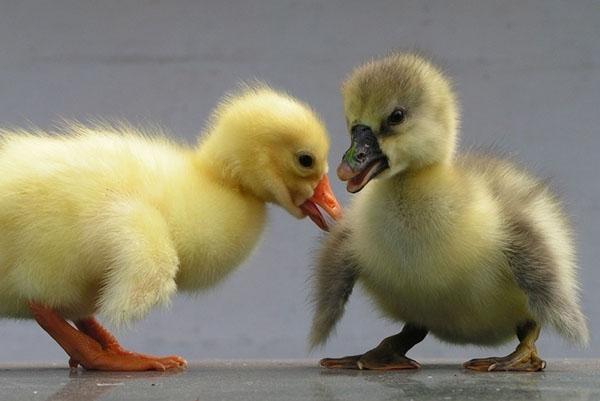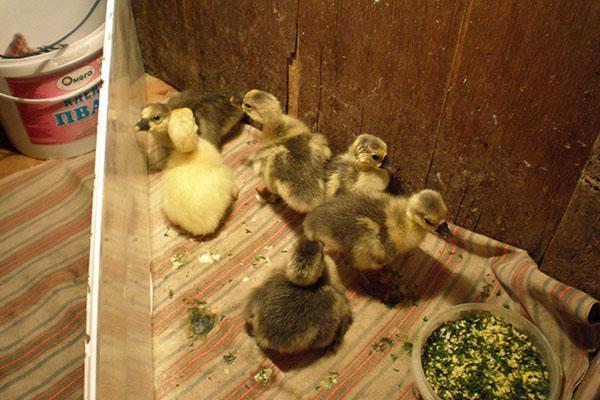Learning to raise and care for goslings at home
 Growing goslings at home is considered a profitable business. Adult birds are used for two purposes - for meat or for obtaining eggs. Chicks reach maturity in 4-6 months. From the first days, proper care is needed for them in order for the majority to survive. Novice poultry breeders need to remember the rules and recommendations that will help take good care of the goslings. If you follow them, babies will grow up healthy, and they can be used for their purpose.
Growing goslings at home is considered a profitable business. Adult birds are used for two purposes - for meat or for obtaining eggs. Chicks reach maturity in 4-6 months. From the first days, proper care is needed for them in order for the majority to survive. Novice poultry breeders need to remember the rules and recommendations that will help take good care of the goslings. If you follow them, babies will grow up healthy, and they can be used for their purpose.
Care in the early days

Newly appeared babies should be divided into weak and strong, and then transferred to a warm place. The temperature should be around + 30 ° C. If there is a brood hen, then take the strong chicks to her after 3 days, and leave the weak ones for a couple more days so that they get stronger.
 Keep newborns away from adults. The first ten days, ten heads should fall on one square meter of the pen. Three weeks later, increase the territory, now by 1 sq. meter to settle no more than 3-4 chicks. When the birds are crowded, it is uncomfortable for them to eat and drink, the drinking bowl quickly becomes dirty, which causes the young to get sick. If you do not enlarge the aviary, death is possible
Keep newborns away from adults. The first ten days, ten heads should fall on one square meter of the pen. Three weeks later, increase the territory, now by 1 sq. meter to settle no more than 3-4 chicks. When the birds are crowded, it is uncomfortable for them to eat and drink, the drinking bowl quickly becomes dirty, which causes the young to get sick. If you do not enlarge the aviary, death is possible
The question of how to care for goslings at home worries many novice poultry farmers. Immediately after birth, let the young animals dry out, and after a day try to feed them. The first feed will be corn grits and a boiled egg. You can give fresh grass and crushed grains that have undergone heat treatment already for 3 days. Food should be crumbly, the glued version is unacceptable.
It is necessary to ensure that all birds eat. Individuals who refuse food should be fed in a separate box.
Babies need water. They can not only drink it, but also swim in it almost from the first days. However, it is undesirable for them to splash in the liquid now. Therefore, it is better to install a vacuum drinker that they won't overturn.
 Start taking the kids for a walk when they get a little stronger, they will stand well on their paws and actively move. This will happen in about a week. It will be useful for them to spend 20-30 minutes in the meadow, where they can eat grass and breathe fresh air. A portable aviary will be a good help for a small livestock. Chicks actively peck on grass, because it is their main diet. If it is not possible to release the bird into the reservoir, install wide containers. In hot weather, geese will swim, which will greatly facilitate their maintenance.
Start taking the kids for a walk when they get a little stronger, they will stand well on their paws and actively move. This will happen in about a week. It will be useful for them to spend 20-30 minutes in the meadow, where they can eat grass and breathe fresh air. A portable aviary will be a good help for a small livestock. Chicks actively peck on grass, because it is their main diet. If it is not possible to release the bird into the reservoir, install wide containers. In hot weather, geese will swim, which will greatly facilitate their maintenance.
If the content of the goslings is at a decent level, then the chicks will gain weight in about 60 days. Two months after birth, they already weigh 3 kg or more. At the age of three months, the bird can be cut. At this time, there is very little fat, and the meat is tender and juicy. Finally, geese will become adult 5 months after hatching.
Proper nutrition for goslings
Growing goslings at home will be successful if they are correct feed... It is recommended to give feed mixtures for the first few days after birth.
They should include:
- cottage cheese;
- bran;
- eggs;
- crushed peas;
- oat groats.
Stir in moist green food, as well as potatoes and pumpkin. After three weeks, offer the chicks food waste.
 In order for the birds to grow up healthy, it is imperative to add vitamins A, D, E, B. Please note that some feeds already contain them. To strengthen the immune system, dilute a few grams of biomycin and penicillin in a glass of milk, adding a little sugar. In this form, give antibiotics to chicks.
In order for the birds to grow up healthy, it is imperative to add vitamins A, D, E, B. Please note that some feeds already contain them. To strengthen the immune system, dilute a few grams of biomycin and penicillin in a glass of milk, adding a little sugar. In this form, give antibiotics to chicks.
 Do not forget about compulsory walking. Fresh green grass is an excellent source of vitamins. If it is not possible to send the kids to the meadow, then independently tear the grass and throw it into the aviary. Then the question of how to raise goslings healthy and strong at home will be simplified.
Do not forget about compulsory walking. Fresh green grass is an excellent source of vitamins. If it is not possible to send the kids to the meadow, then independently tear the grass and throw it into the aviary. Then the question of how to raise goslings healthy and strong at home will be simplified.
Where and how to contain?
 Choose a special place for growing goslings at home. Prepare a separate, well-heated room. Keep the temperature at least 30 ° C for the first week. With age, this will no longer be so important, but for now, the babies should be warm. On the 6th day of life, reduce the temperature to 24 ° C, and on the 11th day to 20 ° C. Do not overheat the grown chicks, otherwise their development will slow down. As for humidity, its limit is 75%. In this case, good ventilation is required. Provide an inflow of fresh air, ventilate the room several times a day.
Choose a special place for growing goslings at home. Prepare a separate, well-heated room. Keep the temperature at least 30 ° C for the first week. With age, this will no longer be so important, but for now, the babies should be warm. On the 6th day of life, reduce the temperature to 24 ° C, and on the 11th day to 20 ° C. Do not overheat the grown chicks, otherwise their development will slow down. As for humidity, its limit is 75%. In this case, good ventilation is required. Provide an inflow of fresh air, ventilate the room several times a day.
Do not turn off the lighting for 14 hours a day. In light, chicks eat more and grow faster. If there is no light at night, it will be difficult for them to find their bowls to refresh themselves.
Information on growing goslings at home for beginners will be useful. The above tips and tricks will help you avoid mistakes. Although proper care of the chicks is a painstaking business, it will help to grow healthy young animals.